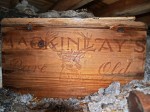In 2006, a team from the New Zealand Antarctic Heritage Trust found a crate of ‘Mackinlay’s Rare Old Highland Malt Whisky’ under the floorboards of Shackleton’s hut at Cape Royds on Ross Island, Antarctica. The whiskey was buried in solid ice along with 4 crates of brandy. Shackleton had brought the liquor with him on his 1907 Nimrod expedition and left it behind when he went home in 1909.
 Whiskey connoisseurs got excited because the original recipe for this particular brew is lost, and given the optimal preservation conditions of Antarctic freeze, this could be the resurrection of a historical liquor. Gratification had to be delayed, however. The crate was frozen solid, embedded in the ice. It wasn’t until just a few months ago that the ice melted just enough for the crate of whiskey, still frozen solid, to be taken out. It was sent to the Canterbury Museum in Christchurch, New Zealand, for very gradual defrosting and very ginger analysis.
Whiskey connoisseurs got excited because the original recipe for this particular brew is lost, and given the optimal preservation conditions of Antarctic freeze, this could be the resurrection of a historical liquor. Gratification had to be delayed, however. The crate was frozen solid, embedded in the ice. It wasn’t until just a few months ago that the ice melted just enough for the crate of whiskey, still frozen solid, to be taken out. It was sent to the Canterbury Museum in Christchurch, New Zealand, for very gradual defrosting and very ginger analysis.
It took them a month to fully thaw the crate, and today they finally opened the lid. (There are some fantastic pictures and details about the long thaw on Canterbury Museum’s The Great Whisky Crate Thaw website.)
Today in a painstakingly slow and careful manoeuvre, the crate was opened to reveal not 12 but 11 bottles of Scotch whisky, carefully wrapped in paper and straw to protect them from the rigours of a rough trip to the Southern Ocean in 1907.
One of the 11 bottles was not as full as the other 10 and it was suspected the twelfth bottle might have been drunk by a member of Shackleton’s crew of the Nimrod who could not resist the temptation.
The whisky is unlikely ever to be tasted and once samples have been extracted and sent to the Scottish distillery which took over the Mackinlay’s distillery many years ago, they will go back to their original home under the floor of Shackleton’s hut in Cape Royds on Ross Island near McMurdo Sound.
Whiskey expert Michael Milne was a witness to the opening. He notes that there was not much information on the label, so we don’t know if it’s a single or blended malt. Hopefully when Whyte and Mackay, the company that today owns the Mackinlay brand, get their clammy hands on the samples, they’ll be able to identify not just the basics like that but also recreate the full recipe.
Until then, nobody gets to take a sip, I’m afraid.